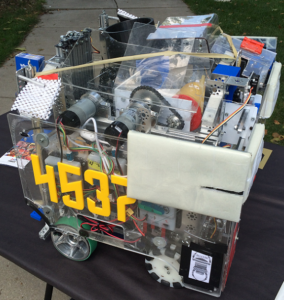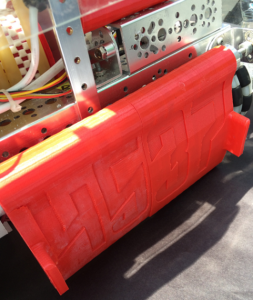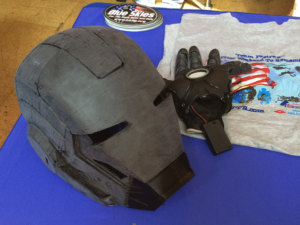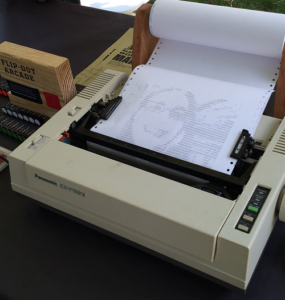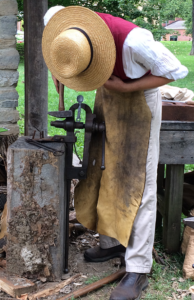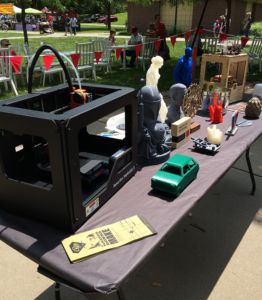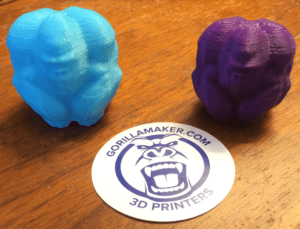 Back in March, when I visited Dayton, Ohio’s resident 3D printing bar, Proto BuildBar, I was told that its employees would be exhibiting at a local school’s STEMfest later that month, and at another educational event this summer: the Dayton Mini Maker Faire. After thoroughly enjoying my visit to STEMfest, I definitely didn’t want to miss the Maker Faire event, which began this Saturday morning at Carillon Historical Park, a 65-acre park with historic exhibits and buildings that explains and celebrates both the history of technology and the history of Dayton.
Back in March, when I visited Dayton, Ohio’s resident 3D printing bar, Proto BuildBar, I was told that its employees would be exhibiting at a local school’s STEMfest later that month, and at another educational event this summer: the Dayton Mini Maker Faire. After thoroughly enjoying my visit to STEMfest, I definitely didn’t want to miss the Maker Faire event, which began this Saturday morning at Carillon Historical Park, a 65-acre park with historic exhibits and buildings that explains and celebrates both the history of technology and the history of Dayton.
 The Dayton area is a major innovation hub: it’s home to Wright Patterson Air Force Base, the largest single site employer in the state, and all sorts of useful things were invented here, like the cash register, the Boolean search method, pop-top cans, and oh yes, that little thing we call an airplane. So holding the second annual event at Carillon Historical Park, which pays homage to the many major inventions of the region, made a lot of sense. Chances are, if you grew up in the area like I did, you took a field trip to the park in elementary school and had class in the one-room schoolhouse on campus, just like in the olden days.
The Dayton area is a major innovation hub: it’s home to Wright Patterson Air Force Base, the largest single site employer in the state, and all sorts of useful things were invented here, like the cash register, the Boolean search method, pop-top cans, and oh yes, that little thing we call an airplane. So holding the second annual event at Carillon Historical Park, which pays homage to the many major inventions of the region, made a lot of sense. Chances are, if you grew up in the area like I did, you took a field trip to the park in elementary school and had class in the one-room schoolhouse on campus, just like in the olden days.
The long list of exhibitors was dizzying, with events and activities ranging from tech-related (3D printing, robotics, and virtual reality) to the more unique (blacksmithing, cosplay, and knitting). There was so much to see, I ended up visiting the Faire again on Sunday, with my husband, so I could take it all in.
The event description on the website reads, “Maker Faire is a gathering of fascinating, curious people who enjoy learning and who love sharing what they can do. From engineers to artists to scientists to crafters, Maker Faire is a venue for these ‘makers’ to show hobbies, experiments, projects. We call it the Greatest Show (& Tell) on Earth – a family-friendly showcase of invention, creativity, and resourcefulness.”
 When I walked in, I immediately spotted the booth for Kentucky-based 3D printing company GorillaMaker, which 3DPrint.com first heard about last summer. Shelley Warner, one of the team members manning the space, told me that the company has manufactured over nine 3D printer models, including its flagship 10″ x 14″ x 16″ GM3D500, the first of which they call the Lulu 1, which has logged over 18,000 hours of print time since its inception and was busily printing colorful gorillas out of PLA the whole weekend. The company also developed an inexpensive 8″ x 8″ x 10″ 3D printer kit for businesses that are just getting off the ground, and offers STEM kits for educators.
When I walked in, I immediately spotted the booth for Kentucky-based 3D printing company GorillaMaker, which 3DPrint.com first heard about last summer. Shelley Warner, one of the team members manning the space, told me that the company has manufactured over nine 3D printer models, including its flagship 10″ x 14″ x 16″ GM3D500, the first of which they call the Lulu 1, which has logged over 18,000 hours of print time since its inception and was busily printing colorful gorillas out of PLA the whole weekend. The company also developed an inexpensive 8″ x 8″ x 10″ 3D printer kit for businesses that are just getting off the ground, and offers STEM kits for educators.
“Everybody is interested in 3D printing,” Warner told me. “It intrigues everyone.”
Shelley’s husband is Glenn Warner, the founder and “ZooKeeper” of GorillaMaker, which got its start in the Warner kitchen. Warner, who’s also a published author, told me that it took him 57 failures before he finally built the successful Lulu 1, and that he sold 10 units in the first 90 days after he introduced the printer. He also said that the company offers an atypical three-year warranty on the printer, which features an aluminum frame and a flexible bed, and that the Lulu is in 120 schools all around the US; Warner also travels to schools giving talks to students about achieving success.
I asked Warner if they’d had a lot of visitors at the event, and he enthusiastically responded that they had, with many school IT managers visiting the booth on Saturday and lots of teachers teachers visiting on Sunday; good news for an event centered around STEAM education and activities. Warner said he had an “unbelievable time” at the Maker Faire, and that they gave away 600 3D printed gorillas to people. He mentioned that he was also working on 3D printed prosthetics, and that he was donating a 3D printer to a local military veteran who was 3D printing prosthetics for other veterans. He pointed across the hall, and I saw that it was none other than Tim O’Sullivan; we’ve really enjoyed seeing his 3D printed Iron Man suit and 3D printed War Machine Mark III suit. O’Sullivan was supporting both making and veterans at the event – he had the War Machine suit with him at the booth, which also had information on the nonprofit organization Blue Skies For the Good Guys and Gals Warrior’s Foundation, for Team Fastrax Warrior Weekend to Remember. The organization’s mission is to honor US veterans, wounded warriors, and the families of the brave men and women who gave their lives for our country.He showed me the prosthetic he’s currently working on, and said that CAD/CAM system supplier Vorum, the Canada-based maker of Canfit Design Software, is donating a 3D scanner to him, and will also be personally training him on the scanner and its software, so he can continue to make prosthetics. O’Sullivan has a lot going on right now, which I hope to learn more about at a later date, but did mention that one of his next big 3D printing projects will likely be C3PO from Star Wars.
O’Sullivan was supporting both making and veterans at the event – he had the War Machine suit with him at the booth, which also had information on the nonprofit organization Blue Skies For the Good Guys and Gals Warrior’s Foundation, for Team Fastrax Warrior Weekend to Remember. The organization’s mission is to honor US veterans, wounded warriors, and the families of the brave men and women who gave their lives for our country.He showed me the prosthetic he’s currently working on, and said that CAD/CAM system supplier Vorum, the Canada-based maker of Canfit Design Software, is donating a 3D scanner to him, and will also be personally training him on the scanner and its software, so he can continue to make prosthetics. O’Sullivan has a lot going on right now, which I hope to learn more about at a later date, but did mention that one of his next big 3D printing projects will likely be C3PO from Star Wars. Outside of the main building, there was a stage set up on the back lawn where families were watching local educator Mister C perform live science experiments. He works to create Science Boot Camps for students and teachers, and also makes videos to help kids learn about math and science concepts. He asked for multiple volunteers to help with his experiments, one of which involved using pressurized air to suspend a ball in midair.
Outside of the main building, there was a stage set up on the back lawn where families were watching local educator Mister C perform live science experiments. He works to create Science Boot Camps for students and teachers, and also makes videos to help kids learn about math and science concepts. He asked for multiple volunteers to help with his experiments, one of which involved using pressurized air to suspend a ball in midair.
 Several area libraries had stands and booths at the Maker Faire, including the Wright Memorial Public Library, which had brought a Makey Makey invention kit in one its Makerboxes. The library has over 20 boxes that can be checked out for home use, including ones for littleBits, Raspberry Pi, and engineering. This particular kit taught you how to write a program in Scratch that tells a computer to make a specific sound when a certain key is pressed. Then you can make a piano using a white tarp and black tape, and map the keyboard keys – using the Makey Makey, metallic tape, and wire – to the piano keys, to create a musical project that’s fun for the whole family.
Several area libraries had stands and booths at the Maker Faire, including the Wright Memorial Public Library, which had brought a Makey Makey invention kit in one its Makerboxes. The library has over 20 boxes that can be checked out for home use, including ones for littleBits, Raspberry Pi, and engineering. This particular kit taught you how to write a program in Scratch that tells a computer to make a specific sound when a certain key is pressed. Then you can make a piano using a white tarp and black tape, and map the keyboard keys – using the Makey Makey, metallic tape, and wire – to the piano keys, to create a musical project that’s fun for the whole family.
The Greene County Public Library makerspace is called Spark Place, and has a CNC milling machine, soldering stations, 3D scanners, and a few 3D printers. As the printers were all in use at the library this weekend, the employees brought some small 3D printed objects, as well as their their button-making machine, to the event. Spark Place also offers weekend classes on topics like CAD and chainmaille jewelry-making.
“It’s cool to see a lot of people coming out, excited about STEAM activities,” Cara Kouse, the Innovation and Makerspace Manager at the library, told me. “It’s fun to see how many people turn up at these events to learn in a fun way.”
 Kouse also said that these types of events are really important, because they “improve literacy” about STEAM education and making. I ventured over to a large plaza next, where Proto BuildBar was showing off one of its MakerBot 3D printers, lots of 3D printed objects, and $20 Learn to Solder Kits by MCM Electronics; there were also multiple soldering stations set up, and they even had their cool Typewriter Selfie station going. Proto BuildBar is sponsoring the Dayton Regional STEM School‘s FIRST Robotics team.
Kouse also said that these types of events are really important, because they “improve literacy” about STEAM education and making. I ventured over to a large plaza next, where Proto BuildBar was showing off one of its MakerBot 3D printers, lots of 3D printed objects, and $20 Learn to Solder Kits by MCM Electronics; there were also multiple soldering stations set up, and they even had their cool Typewriter Selfie station going. Proto BuildBar is sponsoring the Dayton Regional STEM School‘s FIRST Robotics team.
Team mentor Juanita told me that this international program is “more than just robots,” and that the kids also learn about professionalism, 3D printing, CAD programs, and public speaking. They design robots from the ground up in less than two months for competitions, and their team’s robot featured some 3D printed and laser cut parts; the kids also use 3D printing to make keychains to sell for fundraising efforts.
“They learned what kinds of mediums they need to print in, and they also print extra parts and replace them on the robot,” Juanita told me.
 I also had an opportunity to speak with Pedro, a member of the BONDS Robotics First Robotics Competition (FRC) team. The team is made up of members from multiple area high schools.
I also had an opportunity to speak with Pedro, a member of the BONDS Robotics First Robotics Competition (FRC) team. The team is made up of members from multiple area high schools.
“You’re working as a team,” Pedro told me. “We get to build upon skills we don’t learn in school. It’s an amazing opportunity for kids.”
Some of the other booths I saw included the Dayton chapter of nonprofit organization Girl Develop It, virtual reality and augmented reality demonstrations by holosoft, a rocket launch, and even some of the world’s original makers in the historic buildings, who were making candles, dresses, and even a silverware set. On my way out, I passed the Spark Place table again, and heard a kid tell his mother “I want to make those!” about the 3D printed objects on display…and really, that’s what maker faires are all about – getting excited about making.
You can check out more photos from my visit to the Dayton Mini Maker Faire below:
- Tim O’Sullivan’s prosthetic
- Typewriter Selfie
- Proto BuildBar
Discuss in the Dayton Mini Maker Faire forum thread at 3DPB.com.
[All photos: Sarah Saunders]Subscribe to Our Email Newsletter
Stay up-to-date on all the latest news from the 3D printing industry and receive information and offers from third party vendors.
You May Also Like
Profiling a Construction 3D Printing Pioneer: US Army Corps of Engineers’ Megan Kreiger
The world of construction 3D printing is still so new that the true experts can probably be counted on two hands. Among them is Megan Kreiger, Portfolio Manager of Additive...
US Army Corps of Engineers Taps Lincoln Electric & Eaton for Largest 3D Printed US Civil Works Part
The Soo Locks sit on the US-Canadian border, enabling maritime travel between Lake Superior and Lake Huron, from which ships can reach the rest of the Great Lakes. Crafts carrying...
Construction 3D Printing CEO Reflects on Being Female in Construction
Natalie Wadley, CEO of ChangeMaker3D, could hear the words of her daughter sitting next to her resounding in her head. “Mum, MUM, you’ve won!” Wadley had just won the prestigious...
1Print to Commercialize 3D Printed Coastal Resilience Solutions
1Print, a company that specializes in deploying additive construction (AC) for infrastructure projects, has entered an agreement with the University of Miami (UM) to accelerate commercialization of the SEAHIVE shoreline...



